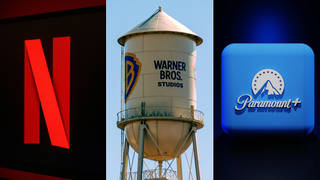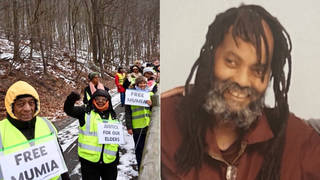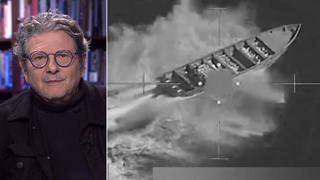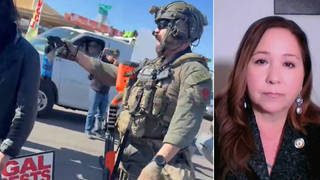
Guests
- Ron SuskindPulitzer Prize-winning journalist who has written for Time Magazine, The New York Times Magazine, Esquire and the Wall Street Journal. His most recent book is called, “Confidence Men: Wall Street, Washington, and the Education of a President.”
An explosive new book that draws a searing portrait of the Obama administration’s failings, and early management of the economic crisis, has been met with sharp objections from officials within and outside of the White House. We speak with veteran journalist Ron Suskind, author of “Confidence Men: Wall Street, Washington, and the Education of a President.” He writes that U.S. Treasury Secretary Tim Geithner ignored an order from President Obama to consider dissolving the debt-ridden banking giant Citigroup as part of a reconstruction of major banks in March 2009. Suskind argues that Citigroup was one of several incidents where President Obama’s authority was “systematically undermined or hedged by his seasoned advisers.” In the book based on interviews with more than 200 people, including former and current members of the Obama administration, as well as the President himself, Suskind also says the White House is a hostile workplace for women. [includes rush transcript]
Transcript
JUAN GONZALEZ: The release of an explosive new book that draws a searing portrait of the Obama administration’s failings and early management of the economic crisis has been met with sharp objections from officials within and outside of the White House. In his book Confidence Men, veteran journalist Ron Suskind writes that U.S. Treasury Secretary Tim Geithner ignored an order from President Barack Obama to consider dissolving the debt-ridden banking giant Citigroup as part of a reconstruction of major banks in March 2009. Suskind goes on to say that Citigroup was one of several incidents where President Obama’s authority was, quote, “systematically undermined or hedged by his seasoned advisers.” He also reports Larry Summers, former chair of the National Economic Council, once said at a meeting, quote, “We’re really home alone. There’s no adult in charge. Clinton would never have made these mistakes.”
Earlier this week, White House Press Secretary Jay Carney responded to some of the allegations in Suskind’s book.
PRESS SECRETARY JAY CARNEY: I, too, have not read the book, although I’ve read a lot about it. What we know is that very simple things, facts that could be ascertained—dates, titles, statistics, quotes—are wrong in this book. So I think that—in fact, one passage seems to be lifted almost entirely from Wikipedia in the book. I think, based on that, I would caution anyone to assume that if you can’t get those things right, that you suddenly get the broader analysis right. That analysis is wrong.
AMY GOODMAN: That was Press Secretary Jay Carney, speaking about Pulitzer Prize-winning journalist Ron Suskind’s new book, Confidence Men: Wall Street, Washington, and the Education of a President. Suskind says the book is based on interviews with more than 200 people, including former and current members of the Obama administration, as well as the President himself.
Well, we are joined by Ron Suskind right now. His previous books include the New York Times bestsellers The Way of the World, The One Percent Doctrine, The Price of Loyalty and A Hope in the Unseen. From 1993 to 2000, Suskind was the senior national affairs writer for the Wall Street Journal, where he won the Pulitzer Prize. He now lives in Washington, D.C., writes for Time Magazine, The New York Times Magazine, Esquire and the Wall Street Journal.
Ron, what most surprised you in your research for this book, Confidence Men?
RON SUSKIND: It did surprise me when I began to discover how much the President faced in those first days, how significant the challenges were, but also how much he was ceding authority to a small group of advisers, many of whom, of course, had long experience with one another, dating back to the Clinton years. That was the most surprising thing. And as well, when I found that out, of course, you know, I—as you know, as the Bush administration pointed out, I am a lifelong Democrat, and, you know, some of the things that you’re finding in reporting often, as a reporter, are unsettling. I was very, very ardent about making certain that the book really was true to the idea of the evolution of the President, rather than a snapshot of any place in time, which was the prime driver to the final interview with the President, where he speaks, I think with great strength, about how he has evolved across these tumultuous years.
AMY GOODMAN: At a press briefing on Monday, the director of the Management and Budget, Jack Lew, asked Treasury Secretary Tim Geithner about your book. Here’s how Geithner responded.
TREASURY SECRETARY TIMOTHY GEITHNER: I haven’t read this book, but, to borrow a phrase, I live the reality. And the reports I’ve read about this book bear no resemblance to the reality we live together. No resemblance.
REPORTER: Specifically, though, Mr. Secretary, did you slow-walk on the President’s effort to reorganize banks?
TREASURY SECRETARY TIMOTHY GEITHNER: Absolutely not, and I would never do that. I’ve spent my life in public service. My great privilege to serve this president, and I would never contemplate doing that. But again, I lived the original, and the reality I lived, we all lived together, bears no relation to the sad, little stories I heard reported from that book.
AMY GOODMAN: Tim Geithner, the Treasury Secretary. Ron Suskind, those “sad, little stories,” respond to him, and particularly talk about what you learned about Citigroup, what Geithner did or didn’t do when it came to Obama’s instructions.
RON SUSKIND: Let me—before I get into, I want to just offer something that I think readers are now finding out, is that Tim Geithner responds to the whole Citigroup incident across two pages of long quotes, all taped, obviously, where he deals with it step by step, what he knew, what he didn’t know.
AMY GOODMAN: Because you talked to him.
RON SUSKIND: Of course. Thirty-five-minute interview prior to publication, to make certain that the Treasury Secretary had a chance to respond to this in full. And certainly, “full” is not what we’re seeing here. It is in the book. I suggest readers read that.
I think what happened here is something that I point out in the book, that is as much about circumstances as personal conduct. It was a difficult time. Everybody points that out. At this juncture, however, the President, a month and a half into office, was quite focused on getting his arms around what was clearly the great twin crisis of his presidency: a dropping economy, a collapsing economy, and a collapsed financial system. It is a historic set of crises. Coming through February, as I point out, from many, many meetings that are revealed in the notes and the tapes from interviews with participants, the President was getting an architecture of Japan versus Sweden. He said that in many of his public interviews. He says, “I don’t want to be Japan. I want to be Sweden.” Sweden dealt with its banks. It took tough medicine. Japan supported the banks, much the way the United States is now supporting them. It resulted in two decades of stagnation economically in Japan. The President got this. He’s not an economist, as I point out. But he’s learning quickly.
He comes to fullness in mid-March in this large meeting with all the key combatants there. Interestingly, in this meeting, the President has evolved even more pointedly as to what he wants to do. He is very, very focused on how to resolve—meaning close and reopen and restructure—the major banks, who have an overhang of toxic assets that he feels is really a central problem to economic recovery. In the meetings prior to, he telegraphs this. It’s set up as a showdown, so-called, inside of the White House between two teams. Tim Geithner and his team, they’re in favor of something called the stress test, which started in early February. That essentially was a way the government would rate the banks, almost like Moody’s, and then would publish those ratings with some data, and then investors could invest in the banks, essentially based on the government’s judgment. The view was that if you were such an investor, that would be essentially a guaranteed investment. That was the view, how to get investors to give money to the banks, and guaranteed by the government. Many people felt that wasn’t going to be timely or effective, that we’re in a crisis, we can’t wait until May to have the stress tests come to their conclusion in this way. In the meeting, actually Larry Summers, who was usually allied with Tim Geithner on a first-do-no-harm, more Wall Street-focused and supportive way, was actually against Tim Geithner in the meeting. He was with Christina Romer. The two of them fought, the two teams, Geithner and Lee Sachs, someone from Treasury, versus Romer and Summers. They hashed it out. Geithner said, “Stress tests are plenty. We’ve got what we’re doing. This is not inaction.” Romer and Summers were quite focused, though, saying, “That’s not enough. This is watchful waiting. We need radical surgery.”
And the President agreed with that second view. After several hours, the President said, “This is what I want to do. I want to look at how to restructure these banks, how to resolve them, how government can show accountability flowing in both directions. They messed up. That’s important, that they face consequences. And importantly, we need to show government acting on this, rather than just backing away.”
After the meeting, then the President left and came back. In the interim, Rahm Emanuel stepped up and said that “There’s no way we’re going to be going back to Congress to get money to do anything like this, that everybody needs to” — and he used, you know, several—some strong language. “Everybody needs to get in line to give the President some more modest and pragmatic cause for policy.” When he came back, Larry Summers began, saying, “Mr. President, Rahm Emanuel pointed out when you were away, sir, that we’re not going to get more money from Congress, but there’s $300 billion left in the TARP fund from the previous fall, the bank bailout fund. We can use $200 billion to resolve one bank, Citigroup.” The President took to this after a bit, I think a little reluctantly, according to those there, and said, “All right. But if we take down Citibank, if we do Citibank first, I want to do it right. That will show that we can have a bank closed without a kind of Lehman-style disaster. That will build confidence. It will kill off fear, because that fear we’re feeling right now, just the economic meltdown just in the past few days, is really a fear-driven one.” That’s the President trying to get at that, which of course we all now understand. “We’ll do it right. We’ll do Citigroup right, and then we’ll go back to Congress for more money.” That’s where the meeting comes to its end. The President says, “Tim’s stress tests will move forward, but I want a plan for how to resolve Citigroup.” He’s quite ardent about it.
Three weeks later, at an early April meeting in the Oval Office, the President is discussing this. He mentions, “What about the resolution plan for Citigroup?” And this is a key part of the arsenal. Christina Romer looks over at Larry Summers. Tim Geithner is not at this meeting. And they exchange glances, and she says, “Excuse me, Mr. President, there is no plan for Citigroup.” The President is agitated. He says, “There better be.” After the meeting, Larry Summers huddles with Rahm Emanuel. Rahm is displeased. He says to Summers, “She should never have said that about Citigroup to the President without Tim here to defend himself.” Larry said to Tim—Larry said to Rahm Emanuel, “But she’s right.”
This long series of events and conversations was confirmed by all of the participants. All of them heard this, and none of them disputed it prior to publication of the book. At the end of the day, Tim Geithner responds to all of this in the book, but, as well, the President does in his interview. And that interview, of course, is rendered at the end of the book. The President doesn’t dispute any of it. He says, “I’m trying to remember. OK, I don’t know if 'agitated' was the right word. This was a difficult time.” His expression of what happened is in the book, in paragraph after paragraph, from the tapes. Readers are going to decide for themselves. I think the evidence laid out in this book, as such, shows, with some singular clarity, that this was a slow-walking incident, where the President was slow-walked, so to speak, by his Treasury Secretary.
Now, importantly, in the book, as well, on page 379 of the book, there is a memo, an internal memo which was very important in this White House. It’s from February of 2010. At this point, we’ve had a year-plus of situations not dissimilar to this, and Pete Rouse, who is something of a shadow chief of staff, was the chief of staff in the Senate office, and is quite skilled at sort of management analysis, has been writing notes in meetings. He now writes a memo to the President, a year one review. And in some ways, this memo says, in memo-speak, here’s how you can take control of your White House. In two items in the memo, the second and the fourth items, he says, “When the economic team,” Rouse to the President, “does not like a decision by the President, they have on occasion worked to re-litigate the overall policy.” This is memo-speak for slow-walking: they disagree with the President, let’s just argue it over and over again until the President sees that we’re right and he’s not. As well, “once a decision is made,” the fourth point, “implementation by the Department of the Treasury has at times been slow and uneven. These factors all adversely affect execution of the policy process.” “Execution” meaning carrying out the orders of the President. That is in the memo. My point here in putting it in the book is to not say that this is currently the case. I have no evidence that this is the current situation, but it is part of the evolution of the President to get control and direction of his White House, so it better expresses his will, as we discuss in his interview with me.
AMY GOODMAN: We’re talking to Pulitzer Prize-winning journalist Ron Suskind. His new book, Confidence Men: Wall Street, Washington, and the Education of a President, a book that the Obama team does not like. When we come back, we’re going to talk about women in the White House, what they have to say, and also why Tim Geithner was so tied to Citigroup, why they did not want it to be dismantled. This is Democracy Now!, democracynow.org, The War and Peace Report. Back with Ron Suskind in a minute.
[break]
AMY GOODMAN: Our guest is Ron Suskind, Pulitzer Prize-winning journalist. His book is Confidence Men: Wall Street, Washington, and the Education of a President. Juan?
JUAN GONZALEZ: Well, Ron, I was struck in reading the book that the—you talk obviously not only about the presidency itself, but that year of the campaign and how Obama began to develop his confidence in different folks, especially in the financial world. I was struck by the degree of reliance that he had on the advice of so many folks on Wall Street. And one of the people that features prominently in the book is Robert Wolf, the head of UBS Americas, who most Americans really didn’t know anything about until he became the first golf partner in the first vacation that Obama took on Martha’s Vineyard. Talk about Bob Wolf’s role, his importance to Obama in—before he got elected and then in the presidency.
RON SUSKIND: Yeah, Robert Wolf was sort of the key man for fundraising for the President in New York, primarily on Wall Street, in early 2008 through 2008. They—excuse me, starting in 2007. And they, you know, became close as friends.
But what’s interesting is that, at one point in the book, at the beginning of the book, in early August of 2007, when the economy is shuddering, but people are not yet clear, for the most part, even in the financial industry, largely, what’s happening, and certainly not in the political community, Wolf gets a glimpse of the future. He’s on a yacht in Long Island Sound, a 110-foot yacht owned by a friend of his—he used to work for him—who’s a hedge fund manager. And this hedge fund manager is also very early to feel the credit crisis hit. His fund is melting down while they’re on the boat. He is, of course, very agitated, yelling into his phone. Wolf, at that point just a contributor to the President and very affectionate toward the President, says, you know, “I need to tell this to Barack.” He goes up to the flying deck of the boat, called The Dream in French, and calls Barack Obama and says, “Barack” — it was Obama’s birthday, his 46th birthday — and says — he said, “This is a once-in-a-lifetime event. This is a market-driven disaster coming that will melt the U.S. economy, and maybe the global economy.”
Obama is startled. He had just received economic briefings, which I have in the book, as well, showing the underlying fragility of the U.S. economy, so much of it burdened by leverage and hollowed out at its core, especially because of men in such a difficult shape in the middle and lower working classes. Wages have been flat for 30 years. And Obama gets a glimpse of the future, a hard glimpse. At that moment—and Obama discusses this some in the interview—he begins to move very forcefully, seeing that Wall Street needs to be reformed. He’s ahead of everyone on this. He’s ahead of not only people on Wall Street, but even some in the progressive community. This is what needs to happen. We need to essentially bring probity to this financial industry.
All the way through into the fall, the community that gathers around Obama is an ecumenical, bipartisan community—Paul Volcker; Bill Donaldson, the SEC chairman under George Bush; Robert Reich; Laura Tyson; you know, Robert Wolf, an executive from Wall Street ready to do virtually anything for the President and speak real candor. This group is important to Obama, because it is, in many people’s minds, the kind of group you want in a crisis: nothing in terms of a dog in the fight for any of them, and speaking clearly to Obama. This group, all the way to the fall, is primary and central, at which point, however, they are replaced, for the most part, washed away, certainly by the time the administration starts, by a different group, which are mostly those who are tied in some ways to Robert Rubin and the Clinton administration.
In fact, something I found in the book, which is one of its many disclosures, is that Robert Rubin, the Citigroup chairman and once Treasury Secretary, was offered a dollar-a-year job to have an office in the White House, actually in the administration. He ended up not taking that because Citigroup collapsed and Rubin essentially became toxic. But the primacy, the centrality of the Rubin group, Larry Summers and Tim Geithner, end up in the two key positions of the presidency as economic advisers: Larry Summers, economic adviser; Tim Geithner, Treasury Secretary. And in some ways, the die are cast, at least significantly, at that point. I think that’s clear, looking back.
AMY GOODMAN: Ron Suskind’s book has elicited harsh reaction from the White House since it was published. Current White House Communications Director Dan Pfeiffer said his book is full of, quote, “drama, palace intrigue and salacious details based on anonymous accounts.”
Meanwhile, top economic adviser, Larry Summers, said, “the hearsay attributed to me is a combination of fiction, distortion and words taken out of context. I can’t speak to what others have told Mr. Suskind, but I have always believed that the president has led this country with determined, steady and practical leadership in the economic area.”
And former White House communications director, Anita Dunn, has flat-out denied Ron Suskind’s claim that she said the White House is a “hostile workplace to women.” Speaking to the Washington Post Friday, Dunn said she had point-blank told Suskind that the White House was not a hostile environment.
Ron Suskind, your response? And talk about why you’re saying that.
RON SUSKIND: Yeah, well, Anita Dunn, of course, talked to me extensively about especially the gender issues in both the campaign and in the White House. Her quotes are in the book. Again, the women’s issue is not central, I don’t think, to the flow of the book. It’s important.
AMY GOODMAN: It may not be central to you, but to many it is.
RON SUSKIND: To many people, it is white-hot stuff. Anita discussed, especially, when she arrives at the White House, what she found, in terms of real tension between men and women. What we did here—and let me just sort of describe—you know, the general issues we’ll talk about in a minute, but let me first deal with the Anita Dunn issue—is that she said initially, discussing this, that she discussed with Valerie Jarrett in the White House. She said, you know, if it were not for the President, we would be in court for a hostile workplace, because the place actually fit the legal definition of a hostile workplace toward women.
With Anita Dunn, as with all or most of the other key subjects, I went back, if they have a quote like that that’s going to be defining and attached to their name, I call them back, and I say, “Look, you should know what’s going in the book next to your name.” I did that with Anita Dunn. We discussed the quote. She pushed back at the end, saying, “Look, my husband was general counsel” — this was right before publication — “during this time. If I identified a legal issue in this area in the White House, in present tense, I would have to have told my husband. It will cause difficulty for me and my husband.” I said, “Well, what are you suggesting?” And she says, “Well, I’m talking to you in the spring of this year, and it is a recollection looking back, is where I stand when I say it.” So she said she would think it would be more appropriate and accurate, in her mind, to say, “Looking back, I felt it fit the legal definition of a hostile workplace for women.” I said, “Alright.”
I said, “Well, what about this thing about 'if not for the President'?” It didn’t actually make much sense in the original quote—I meant to talk to her about that—meaning, if it was a different president, but the same hostile workplace, it would somehow be different legally? That doesn’t seem to make sense. She said, “No, no. You’re right. That is confusing. What I meant was that we all had great affection for the President. We would have walked across hot coals for the man.” And I said, “Fine. So the way this quote will appear in the book is that will be a paragraph prior to the quote, because it’s actually not really related to your thoughts about the hostile workplace. And the hostile workplace quote will be from your lips, 'Looking back, this place fit the legal definition of a hostile workplace.'” That’s our discussion prior to publication. So she knew exactly what was going in the book on that issue, on that quote.
When the book came out, you know, understandably, there is a moment where people are stunned. And I’ve been through this many times; many reporters have, journalists. They talk to you. They spend a lot of time with you. I go back to make sure they’ll know exactly what’s going in the book. But, you know, we live in difficult, partisan times. And when the lights come up, and they’re blinding, all sorts of things happen in terms of what’s often called the “Washington walk back” or “non-denial denials.”
I think we would put Larry Summers’ denial in that category. I would also say, I think quite pointedly, that Larry, just like Anita, was told about the Home Alone quote, in its full, three parts — Home Alone, there’s no adult in charge, Clinton wouldn’t make these mistakes — prior to publication. His response is in the book, in a rather full paragraph that responds directly to the quote, rather than just sort of says, you know, I don’t know.
JUAN GONZALEZ: And Ron Suskind, the title—
RON SUSKIND: Yes.
JUAN GONZALEZ: Confidence Men. Why did you settle on that, and its importance in terms of the themes you bring out in the book?
RON SUSKIND: Well, can I just finish up with the women, and I’ll get to that in one second? Is that I think it’s very important to note that the White House pushed me toward Anita Dunn to give voice to the women’s issues, because their view—and I think it is largely true and reflected as such in the book—is that the President did engage on this and certainly ameliorated those issues inside of the White House. That was the reason the White House said Anita Dunn is a person you should talk to who can give it shape and a voice.
The President met with the women in November in the residence. They aired their grievances. The President was sympathetic and attentive. And many of the women, though not much action emerged from that meeting, felt that the President’s empathy was sufficient to ease the situation. The women’s group then met later amongst themselves for support. And so, I think it’s important that people see the evolution of that issue, because the point of this book, in significant and central ways, is the evolution of the person we care most about, the President, the central actor of this period.
Which brings me to the title, Confidence Men. The book never calls anyone a con man. It’s a play on the word “confidence,” because throughout American history, confidence has really been the coin of the realm, all through our difficult moments and our comebacks in America from difficult times. It is often about a leader instilling confidence in the people of the country. Certainly Roosevelt does this to establish his legacy during the Depression. Kennedy, in his way, brings a kind of confidence upon his arrival. Reagan, as I point out in the book, was a master at projecting confidence. And that’s why this issue of confidence is central, and central to the interview with the President. He speaks eloquently about how he sees confidence being more aptly used, now that he has learned what he’s learned.
AMY GOODMAN: Ron Suskind, I want to thank you for being with us. We’re going to go to part two of this interview in our post-show, and we’ll put it up as a web exclusive at democracynow.org. Ron Suskind is a Pulitzer Prize-winning journalist, author of his latest book, Confidence Men: Wall Street, Washington, and the Education of a President.













Media Options